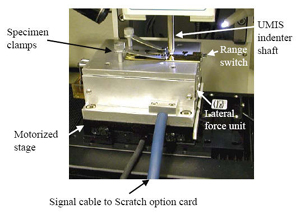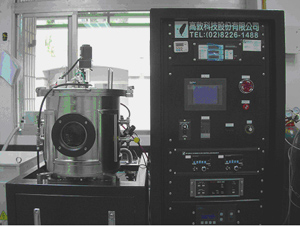|
Nanoindenter
(UMIS, Based Model, CSIRO,
Australia)
Nanoindenter can analysis nanostructures, thin film
materials, and mechanical properties of biological tissues. We can
measure the hardenss, Young's modulus, yielding strength, and fracture
toughness of materials, by measure the load and depth curves. With the
curve, we can also analysis the deformation behavior of the
materials.
|
 |
|
Nanoindenter
(TriboLab, Hysitron, USA)
Nanoindenter can analysis nanostructures, thin film materials, and
mechanical properties of biological tissues. We can measure the
hardenss, Young's modulus, yielding strength, and fracture toughness of
materials, by measure the load and depth curves. With the curve, we can
also analysis the deformation behavior of the materials.
|
 |
|
Nanoscratch Test
(UMIS, Based Model, CSIRO,
Australia)
The nanoindenter which is equipped with the nanoscratch test module can conduct nanoscratch test to nanostructure and thin film materials. By measuring the change of load, displacement, depth, and friction coefficient, we can analysis wear properties,the adhesion strength of the thin film interface, and deformation behaviors of materials.
|
 |
|
Tube Furnace
(VF-360-3-12)
Tube furance can conduct high temperature and vacuum heat treatment, and control the heating/cooling velocity by the program.
|
 |
|
Magnetron Sputter
(Kao Duen Technology
Corporation, Taiwan)
The magnetron sputter can conduct DC sputtering and RF sputtering with high efficiency so as to prepare metal or nitride high quality thin films which are dense, homogeneous. We can change the quality and property of sputtering by adjusting the power and bias voltage of the sputter.
|
 |
|
In-Situ
TEM/Nanoindent
(PI-95 TEM Picoindenter, Hysitron, USA)
The TEM which is equipped with the in-situ nanoindent module can immediately observe the deformation, fracture behavior of materials, and even the movement of atoms during the experiment by the diffraction analysis, nanosturcture images, and lattice images of TEM. The advantage of this module can not only get the testing information immediately but also aviod the error caused by long-term materials aging or contamination. It's more effective way to clarify the deformation mechanism and the fracture behavior of materials.
|

|
|

